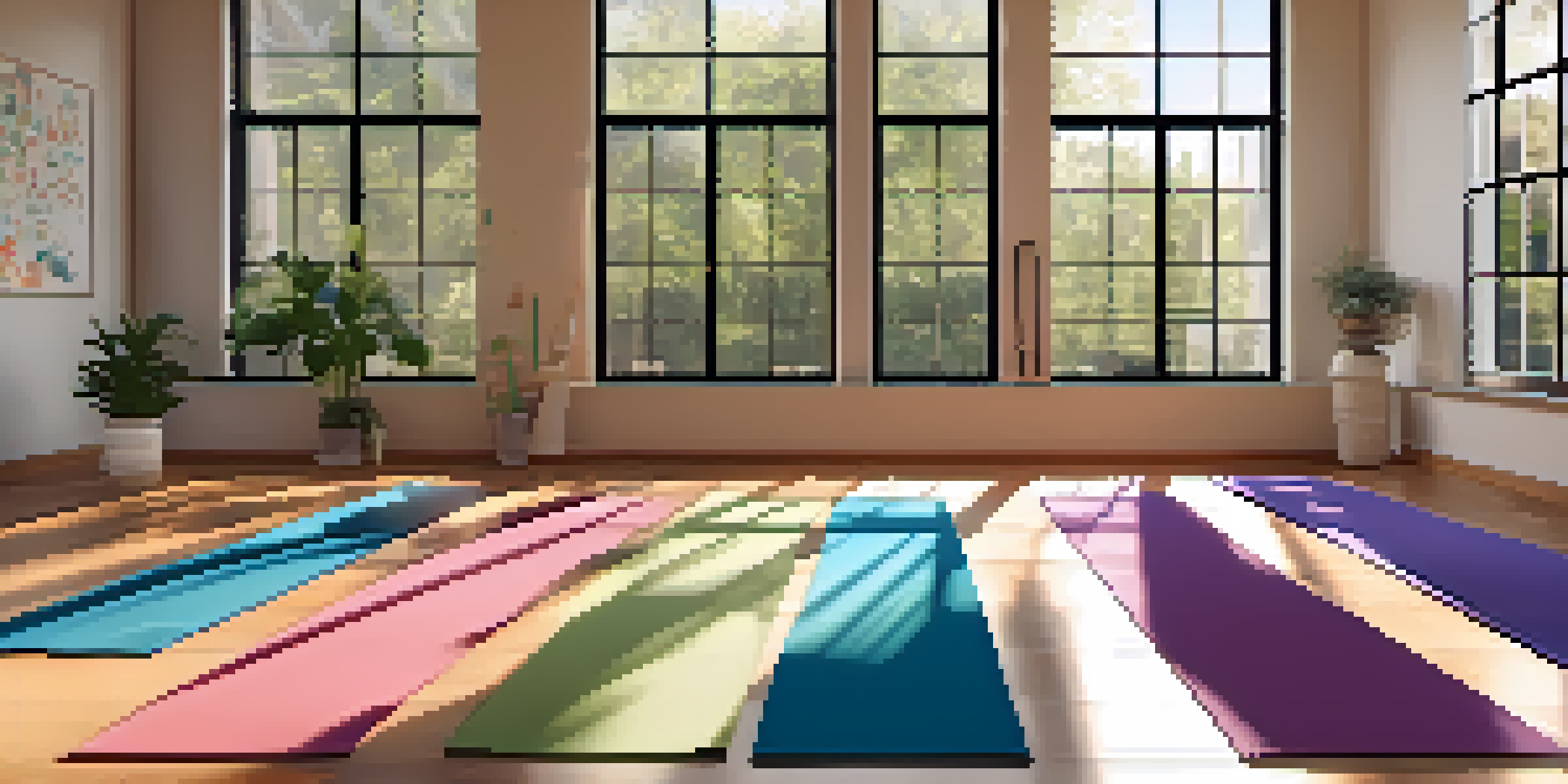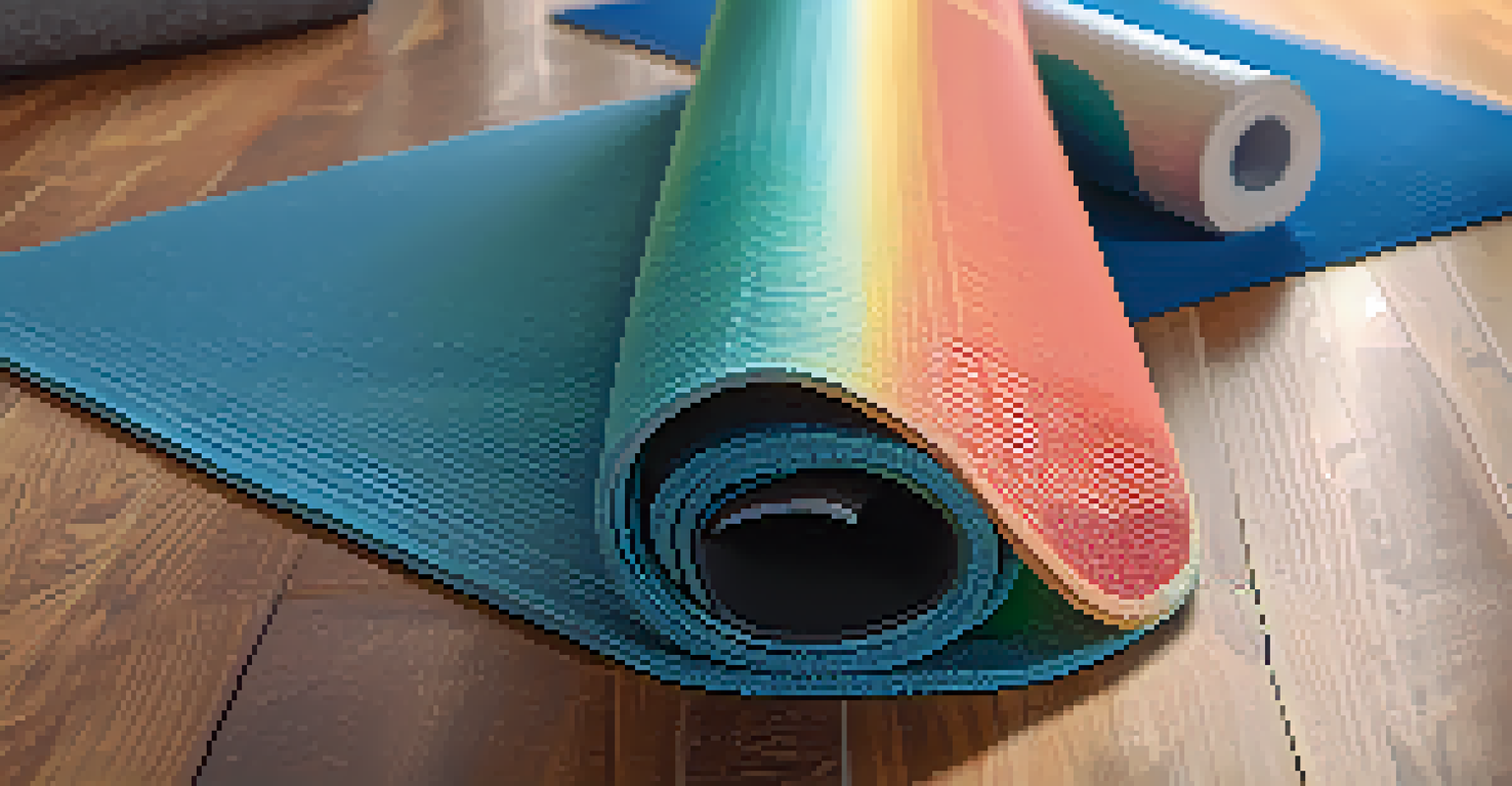Choosing the Right Yoga Mat: A Guide for Beginners

Understanding the Importance of a Good Yoga Mat
Choosing the right yoga mat is crucial for your practice. A quality mat provides the necessary grip, comfort, and support, allowing you to focus on your poses rather than slipping or discomfort. Think of it as the foundation of your yoga journey; just like a solid base is essential for building a house, a good mat supports your body during each session.
The yoga mat is a reflection of you. It holds your practice and invites you to explore your body in ways that are unique to you.
A mat that suits your needs can enhance your performance and help prevent injuries. For beginners, understanding what to look for in a mat is key. After all, the right mat can make those challenging poses a little more manageable.
Moreover, a good yoga mat can be an investment in your physical and mental well-being. It encourages you to practice regularly, creating a more profound connection with your body and mind. So, let's dive into what makes a mat the right one for you!
Material Matters: Choosing the Right Type of Yoga Mat
Yoga mats come in various materials, each with its unique benefits. Common options include PVC, TPE, natural rubber, and jute. PVC mats are durable and affordable, making them great for beginners, while natural rubber mats provide excellent grip and eco-friendliness for those concerned about the environment.

Consider how often you'll practice and the type of yoga you'll be doing. If you sweat a lot or practice hot yoga, look for a mat that offers superior grip, even when wet. TPE mats are often more lightweight and provide cushioning, ideal for those who prefer a softer feel underfoot.
Choose the Right Yoga Mat
Selecting a quality yoga mat enhances your practice by providing the necessary grip, comfort, and support.
Ultimately, the material you choose should align with your values and practice style. Testing out different types at a local studio or store can help you find the perfect fit for your personal preferences.
Thickness: Finding Your Ideal Yoga Mat Comfort Level
The thickness of your yoga mat can significantly impact your comfort during practice. Mats typically range from 1/16 inch to 1/4 inch thick. A thicker mat offers more cushioning, perfect for sensitive joints, while a thinner mat provides stability and connection to the ground, beneficial for balance poses.
Yoga is not about touching your toes, it’s about what you learn on the way down.
For beginners, a standard thickness of around 1/8 inch is often a good starting point. This thickness provides a balance between comfort and stability, allowing you to explore various poses without feeling too cushioned or unstable. Think of it like choosing the right pillow; too soft can cause you to sink in, while too firm can be uncomfortable.
As you progress in your practice, you may find your preference for thickness changes. Don't hesitate to experiment with different options to discover what feels best for you.
Texture and Grip: Ensuring Stability During Practice
The texture of your yoga mat plays a vital role in how well you can grip it during your practice. Some mats have a smooth surface, while others feature a textured finish to enhance traction. A mat with good grip helps prevent slipping, especially in poses where you need to hold your weight.
For beginners, it’s essential to choose a mat that provides enough grip for your style of practice. If you're doing vinyasa or power yoga, opt for a mat with a more textured surface. This will help you stay stable as you flow from one pose to another.
Material and Thickness Matter
The material and thickness of your mat can significantly affect your comfort, stability, and overall experience during yoga.
As you become more familiar with your practice, you'll develop a better sense of what type of grip feels right for you. Testing different mats can help you find the perfect balance between comfort and stability.
Weight and Portability: Choosing a Travel-Friendly Mat
If you plan to take your yoga practice on the go, consider the weight and portability of your mat. Heavier mats can offer more stability but can be cumbersome to carry. Conversely, lightweight mats are easier to transport but may sacrifice some cushioning or durability.
A good travel yoga mat should ideally weigh around 2 to 3 pounds, making it easy to roll up and carry in a bag. Some brands even offer foldable or compact mats designed specifically for travel, which can save space in your luggage.
When weighing your options, think about where you’ll be practicing. If you regularly attend classes or travel, a portable mat can make staying consistent with your practice much easier.
Price Range: Finding a Yoga Mat That Fits Your Budget
Yoga mats come in a wide range of prices, from budget-friendly options to high-end brands. Generally, you can find a decent mat for around $20 to $100. While it's tempting to go for the cheapest option, consider the long-term value of your purchase, as a higher-quality mat may last longer and provide better support.
If you're just starting, it's wise to explore reasonably priced mats that still meet your needs. You can often find mats that offer a good balance of quality and affordability. Look for sales or discounts at local stores or online to snag a great deal.
Personal Preference Counts
Ultimately, the best yoga mat is one that resonates with you, considering factors like feel, color, and design.
Remember, investing a bit more in a good yoga mat can enhance your practice and ensure you’re comfortable and safe as you explore various poses.
Personal Preference: Choosing a Mat That Feels Right to You
Ultimately, the best yoga mat for you is the one that feels right and supports your practice. Everyone's preferences differ, so consider factors like color, design, and even the mat's smell. Some individuals may prefer a vibrant color to energize their practice, while others might opt for neutral tones to create a calming atmosphere.
Don’t forget to think about how a mat feels during practice. If possible, try out a few mats during class or at a local store. Pay attention to how it feels under your hands and feet; it should provide comfort and support without compromising grip.

Trust your instincts and choose a mat that resonates with you. After all, a yoga mat is an extension of your practice, and finding one that you love can make all the difference in your journey.